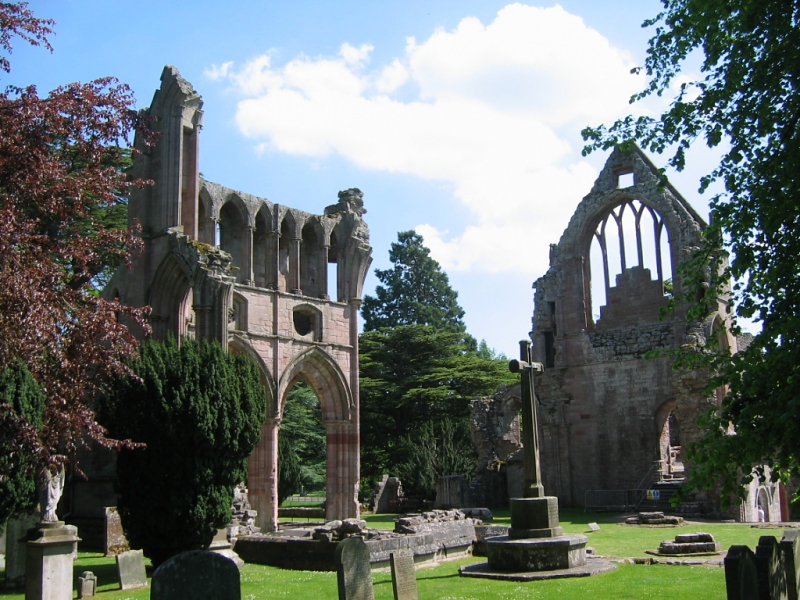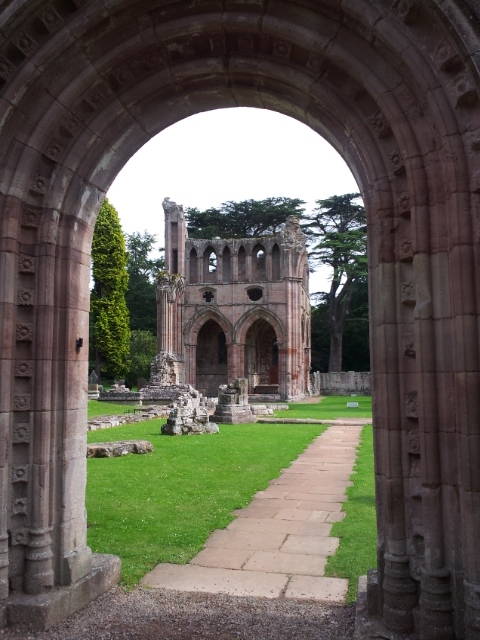
There is a groundskeeper's cottage near the car park at Dryburgh with a cute little girl of about five years old and a much older black Labrador Retriever in the yard. As we retrieve cameras from the trunk of the car, I see the little girl open the gate, and cast a furtive glance over her shoulder.
I know as well as she does that she's not supposed to open that gate and hesitate a moment, the mother in me wanting to tell her to get back in the yard, the tourist in me not wanting to offend should an adult suddenly appear. Thankfully her parents do come out of the house quite suddenly and this little lass gets quite a talking to from her dad.
Situated in a loop of the River Tweed, Dryburgh Abbey is set in the midst of the most pastoral setting we've seen today. It's surrounded by centuries-old trees, one of which is identical to the purplish-red leafed tree under which I stood at Barnard Castle. Winding our way down the path, we pass under another towering tree; this one has leaves of neon green and clusters of tiny greenish-white flowers. A small sign near the trunk identifies this as a lime tree.
I'd read of lime trees in ballads and descriptions of the British countryside before and had never understood how a citrus tree that I know to flourish in the tropical heat of Florida could survive in Britain. My nature guide comes in handy later, listing this as a hybrid ornamental and the purplish-red tree as a copper beech.
Laughter rings out across the lawn and I spy the little girl and her mother on opposite sides of the trunk of a huge oak. They're hiding from each other, going around and around the tree. "Emma," the mother whispers, drawing out the little girl's name. "Mummmmm," Emma responds, giggling. What a wonderful place to grow up, in the shade of these magnificent trees, within sight of these incredible ruins.
The abbey was founded in 1150 by Hugh de Moreville, one of the assassins of Thomas Becket in Canterbury Cathedral. De Moreville had befriended David I in England and was granted extensive estates in the Border country as well as Cunningham and the northern part of Ayrshire. By 1150, when he founded the abbey, De Moreville was the constable of Scotland. He invited the Premonstatensians from Alnwick in Northumberland to set up the house, their first in Scotland. The construction of the abbey took over one hundred years.
The peace of Dryburgh was shattered during the war of independence. In 1322, Edward II's army, retreating south after another unsuccessful invasion heard the abbey's bells ringing in the distance, turned aside and set fire to the place. This was the first of several attacks the canons endured throughout the later middle ages. Robert the Bruce gave financial help for the rebuilding of the abbey.
Monastic life flourished here until the abbey was visited in 1544 by the same Earl of Hertford who had destroyed Kelso Abbey. The Reformation in 1560 was the end of monastic life at Dryburgh. The eight remaining canons embraced the reformed religion and were allowed to remain, but no new members were permitted. By 1584 there were only two remaining.
A document dated 1600 included the observation that "all the convent thairof are now deceissit." In 1786 the abbey was purchased by David Erskine, eleventh earl of Buchan, who is responsible for planting the specimen trees and preserving the ruins of the abbey. Sir Walter Scott is entombed here as well as Field Marshal Earl Haig of Bemersyde, a 12th century estate up the hill from Dryburgh.

Dryburgh Abbey, on the banks of the River Tweed in the Scottish Borders, was nominally founded on 10 November (Martinmas) 1150 in an agreement between Hugh de Morville, Constable of Scotland, and the Premonstratensian canons regular from Alnwick Abbey in Northumberland. The arrival of the canons along with their first abbot, Roger, took place on 13 December 1152.
It was burned by English troops in 1322, after which it was restored only to be again burned by Richard II in 1385, but it flourished in the fifteenth century. It was finally destroyed in 1544, briefly to survive until the Scottish Reformation, when it was given to the Earl of Mar by James VI of Scotland.
Read more about Dryburgh Abbey at Wikipedia.